Guochen Yu
KS-Net: Multi-band joint speech restoration and enhancement network for 2024 ICASSP SSI Challenge
Feb 02, 2024

Abstract:This paper presents the speech restoration and enhancement system created by the 1024K team for the ICASSP 2024 Speech Signal Improvement (SSI) Challenge. Our system consists of a generative adversarial network (GAN) in complex-domain for speech restoration and a fine-grained multi-band fusion module for speech enhancement. In the blind test set of SSI, the proposed system achieves an overall mean opinion score (MOS) of 3.49 based on ITU-T P.804 and a Word Accuracy Rate (WAcc) of 0.78 for the real-time track, as well as an overall P.804 MOS of 3.43 and a WAcc of 0.78 for the non-real-time track, ranking 1st in both tracks.
BAE-Net: A Low complexity and high fidelity Bandwidth-Adaptive neural network for speech super-resolution
Dec 21, 2023



Abstract:Speech bandwidth extension (BWE) has demonstrated promising performance in enhancing the perceptual speech quality in real communication systems. Most existing BWE researches primarily focus on fixed upsampling ratios, disregarding the fact that the effective bandwidth of captured audio may fluctuate frequently due to various capturing devices and transmission conditions. In this paper, we propose a novel streaming adaptive bandwidth extension solution dubbed BAE-Net, which is suitable to handle the low-resolution speech with unknown and varying effective bandwidth. To address the challenges of recovering both the high-frequency magnitude and phase speech content blindly, we devise a dual-stream architecture that incorporates the magnitude inpainting and phase refinement. For potential applications on edge devices, this paper also introduces BAE-NET-lite, which is a lightweight, streaming and efficient framework. Quantitative results demonstrate the superiority of BAE-Net in terms of both performance and computational efficiency when compared with existing state-of-the-art BWE methods.
A General Deep Learning Speech Enhancement Framework Motivated by Taylor's Theorem
Nov 30, 2022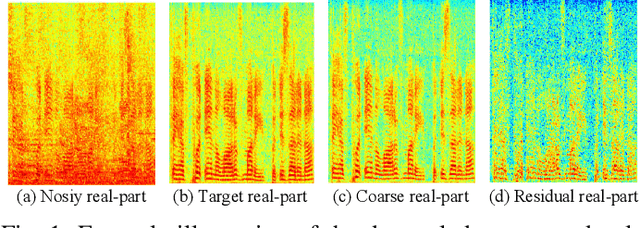
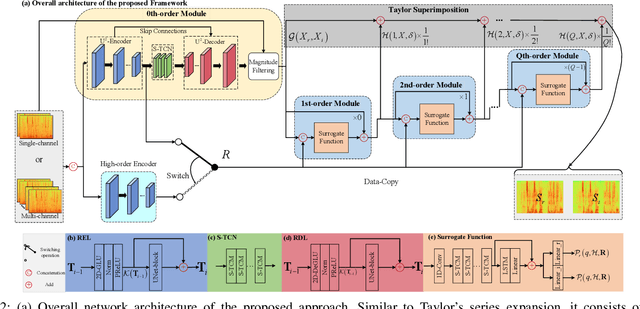
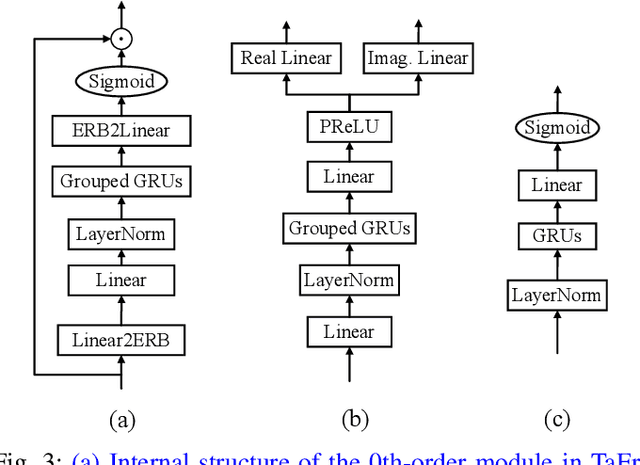
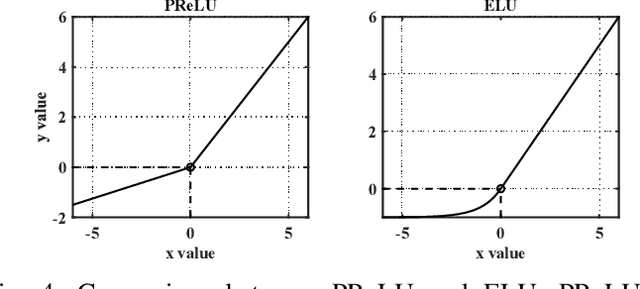
Abstract:While deep neural networks greatly facilitate the proliferation of the speech enhancement field, most of the existing methods are developed following either heuristic or blind optimization criteria, which severely hampers interpretability and transparency. Inspired by Taylor's theorem, we propose a general unfolding framework for both single- and multi-channel speech enhancement tasks. Concretely, we formulate the complex spectrum recovery into the spectral magnitude mapping in the neighboring space of the noisy mixture, in which the sparse prior is introduced for phase modification in advance. Based on that, the mapping function is decomposed into the superimposition of the 0th-order and high-order polynomials in Taylor's series, where the former coarsely removes the interference in the magnitude domain and the latter progressively complements the remaining spectral detail in the complex spectrum domain. In addition, we study the relation between adjacent order term and reveal that each high-order term can be recursively estimated with its lower-order term, and each high-order term is then proposed to evaluate using a surrogate function with trainable weights, so that the whole system can be trained in an end-to-end manner. Extensive experiments are conducted on WSJ0-SI84, DNS-Challenge, Voicebank+Demand, and spatialized Librispeech datasets. Quantitative results show that the proposed approach not only yields competitive performance over existing top-performed approaches, but also enjoys decent internal transparency and flexibility.
TaylorBeamixer: Learning Taylor-Inspired All-Neural Multi-Channel Speech Enhancement from Beam-Space Dictionary Perspective
Nov 30, 2022Abstract:Despite the promising performance of existing frame-wise all-neural beamformers in the speech enhancement field, it remains unclear what the underlying mechanism exists. In this paper, we revisit the beamforming behavior from the beam-space dictionary perspective and formulate it into the learning and mixing of different beam-space components. Based on that, we propose an all-neural beamformer called TaylorBM to simulate Taylor's series expansion operation in which the 0th-order term serves as a spatial filter to conduct the beam mixing, and several high-order terms are tasked with residual noise cancellation for post-processing. The whole system is devised to work in an end-to-end manner. Experiments are conducted on the spatialized LibriSpeech corpus and results show that the proposed approach outperforms existing advanced baselines in terms of evaluation metrics.
TMGAN-PLC: Audio Packet Loss Concealment using Temporal Memory Generative Adversarial Network
Jul 04, 2022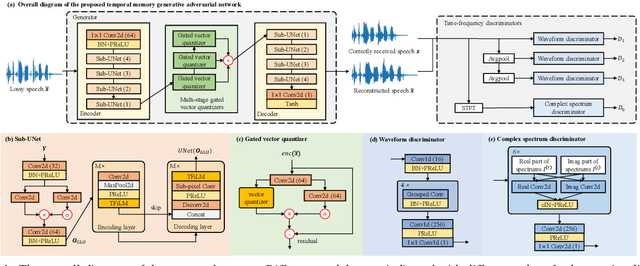
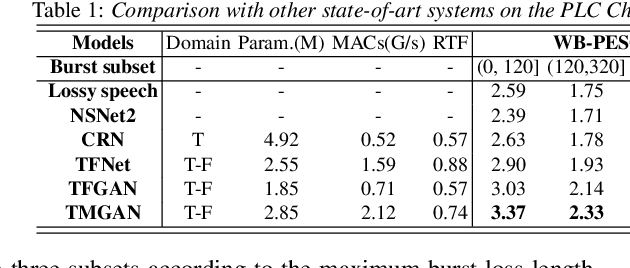
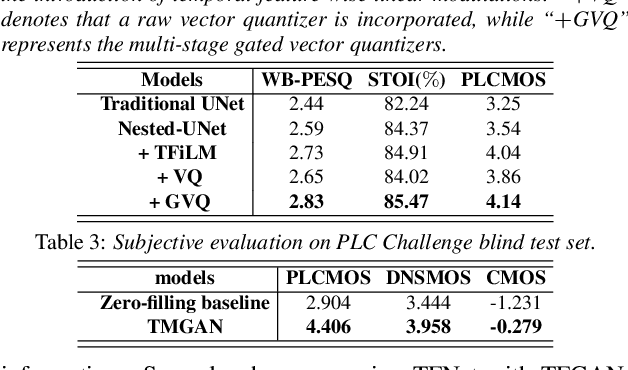
Abstract:Real-time communications in packet-switched networks have become widely used in daily communication, while they inevitably suffer from network delays and data losses in constrained real-time conditions. To solve these problems, audio packet loss concealment (PLC) algorithms have been developed to mitigate voice transmission failures by reconstructing the lost information. Limited by the transmission latency and device memory, it is still intractable for PLC to accomplish high-quality voice reconstruction using a relatively small packet buffer. In this paper, we propose a temporal memory generative adversarial network for audio PLC, dubbed TMGAN-PLC, which is comprised of a novel nested-UNet generator and the time-domain/frequency-domain discriminators. Specifically, a combination of the nested-UNet and temporal feature-wise linear modulation is elaborately devised in the generator to finely adjust the intra-frame information and establish inter-frame temporal dependencies. To complement the missing speech content caused by longer loss bursts, we employ multi-stage gated vector quantizers to capture the correct content and reconstruct the near-real smooth audio. Extensive experiments on the PLC Challenge dataset demonstrate that the proposed method yields promising performance in terms of speech quality, intelligibility, and PLCMOS.
Taylor, Can You Hear Me Now? A Taylor-Unfolding Framework for Monaural Speech Enhancement
Apr 30, 2022

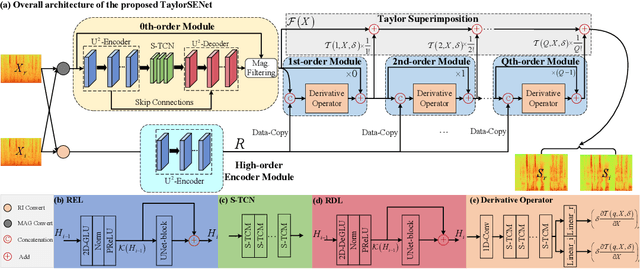

Abstract:While the deep learning techniques promote the rapid development of the speech enhancement (SE) community, most schemes only pursue the performance in a black-box manner and lack adequate model interpretability. Inspired by Taylor's approximation theory, we propose an interpretable decoupling-style SE framework, which disentangles the complex spectrum recovery into two separate optimization problems \emph{i.e.}, magnitude and complex residual estimation. Specifically, serving as the 0th-order term in Taylor's series, a filter network is delicately devised to suppress the noise component only in the magnitude domain and obtain a coarse spectrum. To refine the phase distribution, we estimate the sparse complex residual, which is defined as the difference between target and coarse spectra, and measures the phase gap. In this study, we formulate the residual component as the combination of various high-order Taylor terms and propose a lightweight trainable module to replace the complicated derivative operator between adjacent terms. Finally, following Taylor's formula, we can reconstruct the target spectrum by the superimposition between 0th-order and high-order terms. Experimental results on two benchmark datasets show that our framework achieves state-of-the-art performance over previous competing baselines in various evaluation metrics. The source code is available at github.com/Andong-Lispeech/TaylorSENet.
Optimizing Shoulder to Shoulder: A Coordinated Sub-Band Fusion Model for Real-Time Full-Band Speech Enhancement
Mar 30, 2022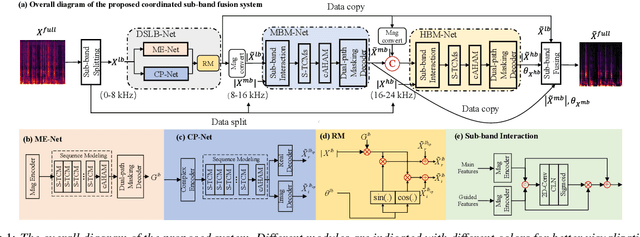
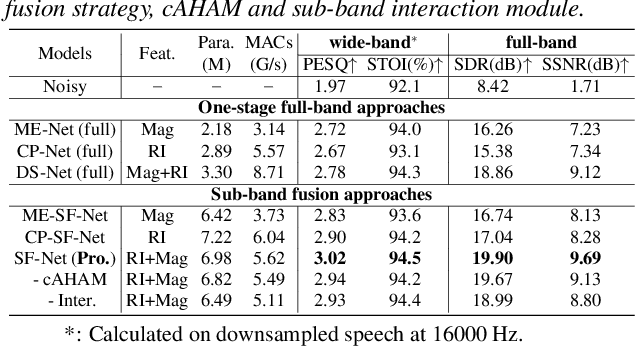
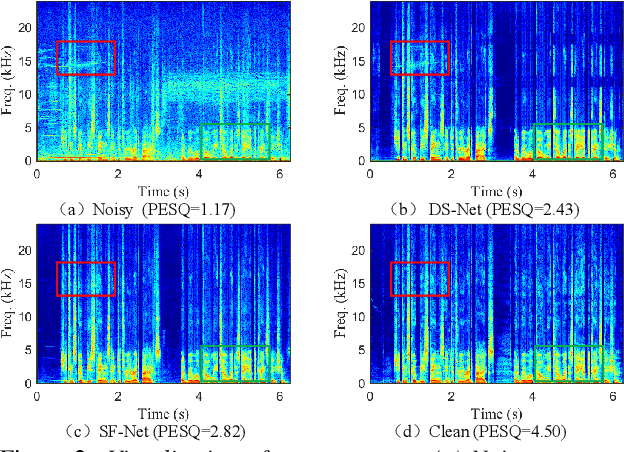
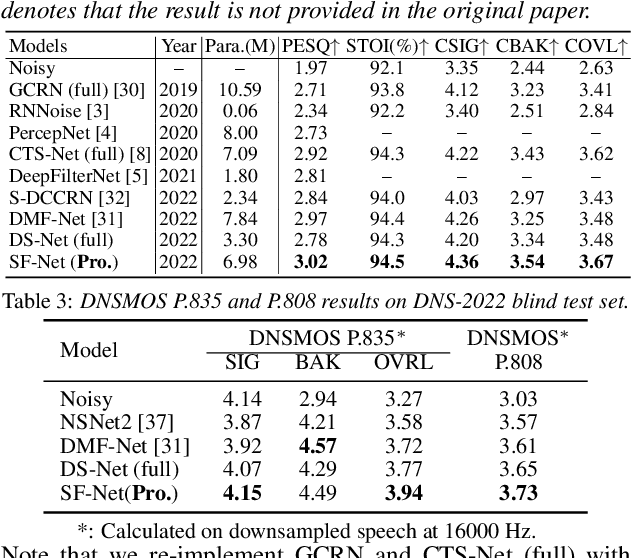
Abstract:Due to the high computational complexity to model more frequency bands, it is still intractable to conduct real-time full-band speech enhancement based on deep neural networks. Recent studies typically utilize the compressed perceptually motivated features with relatively low frequency resolution to filter the full-band spectrum by one-stage networks, leading to limited speech quality improvements. In this paper, we propose a coordinated sub-band fusion network for full-band speech enhancement, which aims to recover the low- (0-8 kHz), middle- (8-16 kHz), and high-band (16-24 kHz) in a step-wise manner. Specifically, a dual-stream network is first pretrained to recover the low-band complex spectrum, and another two sub-networks are designed as the middle- and high-band noise suppressors in the magnitude-only domain. To fully capitalize on the information intercommunication, we employ a sub-band interaction module to provide external knowledge guidance across different frequency bands. Extensive experiments show that the proposed method yields consistent performance advantages over state-of-the-art full-band baselines.
TaylorBeamformer: Learning All-Neural Beamformer for Multi-Channel Speech Enhancement from Taylor's Approximation Theory
Mar 16, 2022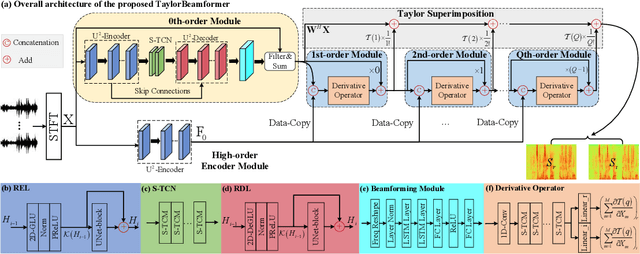
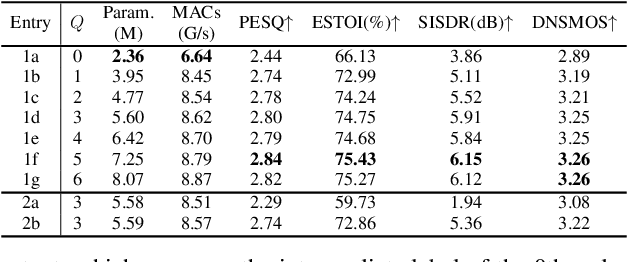
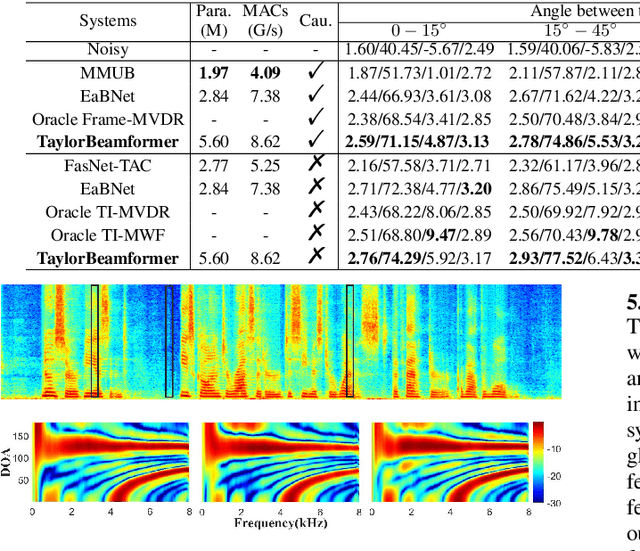
Abstract:While existing end-to-end beamformers achieve impressive performance in various front-end speech processing tasks, they usually encapsulate the whole process into a black box and thus lack adequate interpretability. As an attempt to fill the blank, we propose a novel neural beamformer inspired by Taylor's approximation theory called TaylorBeamformer for multi-channel speech enhancement. The core idea is that the recovery process can be formulated as the spatial filtering in the neighborhood of the input mixture. Based on that, we decompose it into the superimposition of the 0th-order non-derivative and high-order derivative terms, where the former serves as the spatial filter and the latter is viewed as the residual noise canceller to further improve the speech quality. To enable end-to-end training, we replace the derivative operations with trainable networks and thus can learn from training data. Extensive experiments are conducted on the synthesized dataset based on LibriSpeech and results show that the proposed approach performs favorably against the previous advanced baselines.
DMF-Net: A decoupling-style multi-band fusion model for real-time full-band speech enhancement
Mar 02, 2022
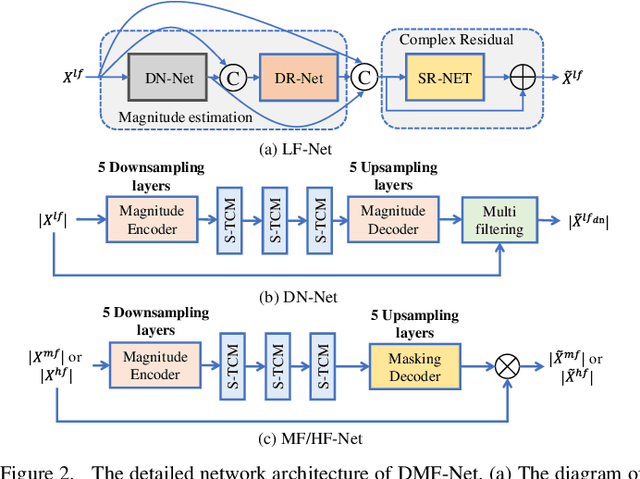

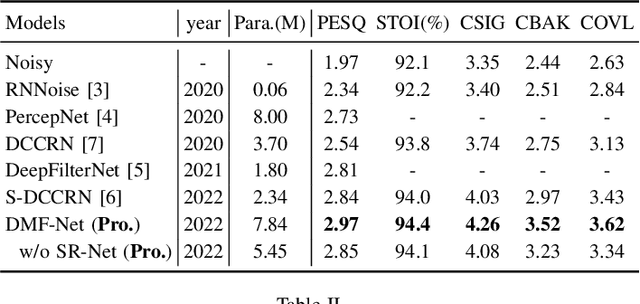
Abstract:Full-band speech enhancement based on deep neural networks is still challenging for the difficulty of modeling more frequency bands and real-time implementation. Previous studies usually adopt compressed full-band speech features in Bark and ERB scale with relatively low frequency resolution, leading to degraded performance, especially in the high-frequency region. In this paper, we propose a decoupling-style multi-band fusion model to perform full-band speech denoising and dereverberation. Instead of optimizing the full-band speech by a single network structure, we decompose the full-band target into multi sub bands and then employ a multi-stage chain optimization strategy to estimate clean spectrum stage by stage. Specifically, the low- (0-8 kHz), middle- (8-16 kHz), and high-frequency (16-24 kHz) regions are mapped by three separate sub-networks and are then fused to obtain the full-band clean target STFT spectrum. Comprehensive experiments on two public datasets demonstrate that the proposed method outperforms previous advanced systems and yields promising performance in terms of speech quality and intelligibility in real complex scenarios.
DBT-Net: Dual-branch federative magnitude and phase estimation with attention-in-attention transformer for monaural speech enhancement
Feb 16, 2022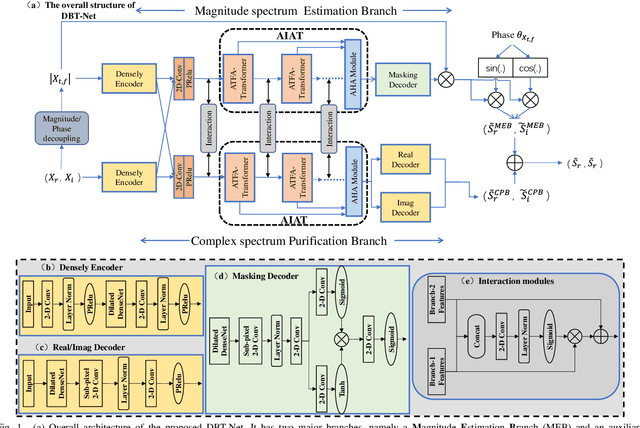
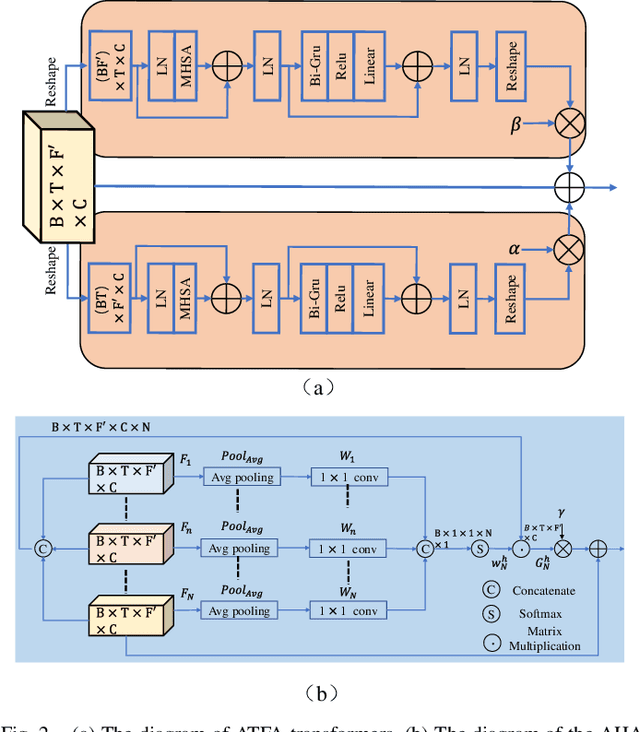
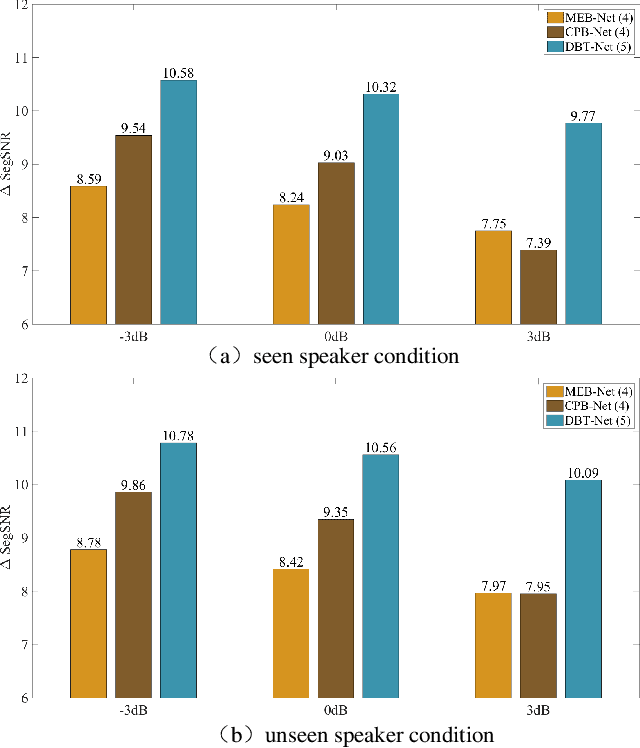
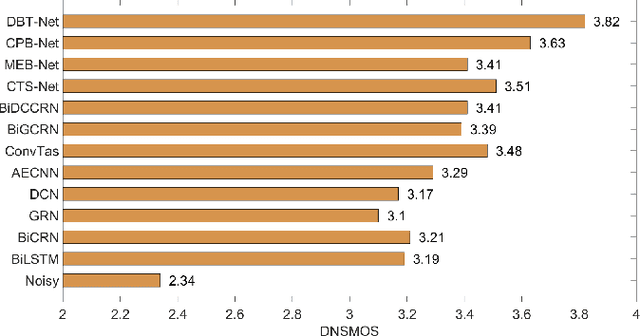
Abstract:The decoupling-style concept begins to ignite in the speech enhancement area, which decouples the original complex spectrum estimation task into multiple easier sub-tasks (i.e., magnitude and phase), resulting in better performance and easier interpretability. In this paper, we propose a dual-branch federative magnitude and phase estimation framework, dubbed DBT-Net, for monaural speech enhancement, which aims at recovering the coarse- and fine-grained regions of the overall spectrum in parallel. From the complementary perspective, the magnitude estimation branch is designed to filter out dominant noise components in the magnitude domain, while the complex spectrum purification branch is elaborately designed to inpaint the missing spectral details and implicitly estimate the phase information in the complex domain. To facilitate the information flow between each branch, interaction modules are introduced to leverage features learned from one branch, so as to suppress the undesired parts and recover the missing components of the other branch. Instead of adopting the conventional RNNs and temporal convolutional networks for sequence modeling, we propose a novel attention-in-attention transformer-based network within each branch for better feature learning. More specially, it is composed of several adaptive spectro-temporal attention transformer-based modules and an adaptive hierarchical attention module, aiming to capture long-term time-frequency dependencies and further aggregate intermediate hierarchical contextual information. Comprehensive evaluations on the WSJ0-SI84 + DNS-Challenge and VoiceBank + DEMAND dataset demonstrate that the proposed approach consistently outperforms previous advanced systems and yields state-of-the-art performance in terms of speech quality and intelligibility.
 Add to Chrome
Add to Chrome Add to Firefox
Add to Firefox Add to Edge
Add to Edge